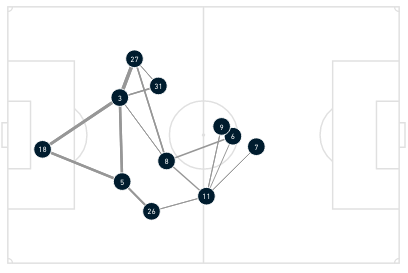Photo: Stephen Speer
The Union’s 1–0 win over the Columbus Crew on Saturday followed the same general pattern of the previous four games: Union defensive dominance, the opposition owning more possession, but the Union handily winning the chance battle. If you hadn’t watched the game, that might be all you’d take away, but those who did watch know that Columbus presented the stiffest challenge the Union have faced in this young season. Why? What was different about what Columbus did?
There is a lot of attention given to possession numbers when it comes to Union games. And this game was another fairly extreme example of possession imbalance. Using MLS’s official stats for the game, the Union controlled only 31% of the ball. But this number, in isolation, doesn’t provide much clarity. The Union are on record saying how little the team wants or needs the ball. They simply don’t need the ball to be effective and dominate games. They’ve lost the possession battle in each game of this five-game win streak, yet won the xG battle (not to mention actual goal battle) in each contest.
So, possession numbers are old news. How then can the eye test from Saturday’s game, which said that Columbus were a more difficult opponent, be confirmed? In short: look at field position.
Dominate space, rather than the ball
Below, see the passing network maps for the Union and Columbus.

Union passing network map

Columbus passing network map
In previous matches this season, these maps were flipped, with the Union the team pushing into the opposition half and dominating the center of the park. Normally, the Union’s diamond midfield and coordinated press prevents teams from being able to maintain possession through the center of the field. Against most modern formations, like 4-3-3 or 4-2-3-1, the Union are able to generate numerical advantages in central spaces, with four midfielders and a striker dropping deep. The Crew lined up in something like a 4-5-1, with the wide players pinching in narrow, and the fullbacks providing width by getting high up the wings. And, as the maps above make clear, the Crew’s striker, Miguel Berry, also dropped deep much of the time.
That’s a lot of bodies in central areas! But having numbers isn’t enough. Even with space so compressed, the Union press is generally still quite effective at disrupting play through the middle, and there should be space behind the opposing fullbacks in wide areas to exploit. And it was indeed through those pockets that the Union were able to generate the chances they did. What made Columbus so effective, in the end, comes down to two players: Darlington Nagbe and Lucas Zelarayán.
As noted, simply flooding the center of the field with players will not guarantee possession against the Union press. Unless, that is, you have players capable of not only receiving the ball under pressure but holding it and then finding the ball that breaks the press. Nagbe may be the best in MLS at doing exactly that. And Zelarayán, upon receiving that press-breaking pass, is excellent at working the spaces between defenders to find overloads or distance shooting opportunities. If those opportunities don’t arise, he is capable of holding the ball long enough to get fouled and get a free kick opportunity.
Given all of that—that Columbus dominated the ball and dominated field position—how is it that the Union still won?
Defensive composure, dangerous attackers
First and foremost, the Union were able to deal with the sustained pressure from Columbus because their defensive communication and composure is so good. They move as a unit and cover for each other when breakdowns occur, all at an elite level. Even though the Union were forced back into their own defensive third for much of the game, Columbus still found it difficult to generate high-quality shooting opportunities. The Crew had more total shots (19 to 10), but only managed to put four of them on frame, one fewer than the Union. The Union’s defense made it very difficult for the Crew to get close to Andre Blake’s goal, and when Columbus did get around and inside the Union box, the Union got goalside and prevented shots without fouling.
That last bit is very important. Save for two free kicks from outside the box, the Union did an excellent job of navigating the pressure from Columbus’s attack without fouling. Give Zelarayán enough chances with a dead ball, and he will make you pay. The Union largely avoided that danger.
So, the Union defense was good enough to earn a scoreless draw, but weren’t the Union pretty lucky to win, given the nature of the goal? Eloy Room is an excellent goalkeeper. The Union didn’t really do anything to “earn” his giant howler. But focusing on the own goal obscures the larger story of the game, which is that the Union’s attackers were consistently dangerous.
Nagbe’s passing and Zelarayán’s movement, assisted by the other right-sided players Yaw Yeboah and Steven Moreira, forced Leon Flach to play almost completely defensively, and prevented Kai Wagner from being as involved as he normally is offensively. However, whether it was through long switches from the center backs, or turnovers generated by pressure, the Union did the things they usually want to do—get to the corners/endline for cutbacks or counterattack a retreating defense. They might have had somewhat fewer opportunities than usual, due to how much farther back the team was positioned, but the chances were there.
Dániel Gazdag generated 0.9 expected goals by himself, with two massive opportunities that Room did very well to prevent. Mikael Uhre was also quite menacing, and could have provided the clinching goal for a teammate had he passed across goal rather than attempting a left-footed shot in the 52nd minute. He drew another good save from Room in the 55th.
Those inclined to grumble will focus on the number of chances that Gazdag and Uhre failed to convert, both in this game and previously. But, leaving aside the fact that Gazdag just scored in four straight games and that Uhre has yet to play a full 90, it is well established that finishing is highly variable, while getting in positions to take shots is not. Gazdag, Uhre, and the rest of the Union attack are getting in better spots than they have in years past. The goals will come. Frankly, the goals have already come, with the Union tied for fourth in the league in goals scored, third in expected goals, second in goal difference, and leading the league in expected goal difference (according to fbref.com).
If the game was played back again, with all the chances repeated, there’s every reason to expect Room doesn’t throw the ball into his own net, but Gazdag scores one if not both chances he had. There was nothing lucky about the win.
And that’s the story of this Union team, currently. They are a grinding defensive machine that is incredibly difficult to break down. Add in that they also seem to be a top-end team at creating chances, and you have the only undefeated team in MLS.


The biggest worry about the U over the last couple of seasons has been “Can they break down a bunkered defense?”. The interesting thing now is that they are now difficult to break down (without added bunkering), allowing them the opportunity to counter attack opposition that gets frustrated and throws more players forward. And I at least have faith that the Union attackers have the ability to generate shots and crash the net against teams that start bunkering.
The season is young, but so far the only team that tried to bunker was Charlotte, sort of, and the Union broke that in minute four of that game. Good signs, for sure.
This game caused more jitters for me than any other so far. Yet, here they are… still undefeated. What a team.
That Columbus midfield is so darn good – watching them string passes together and break formations down is poetic. They simply ran into the wall that is the Union back line.